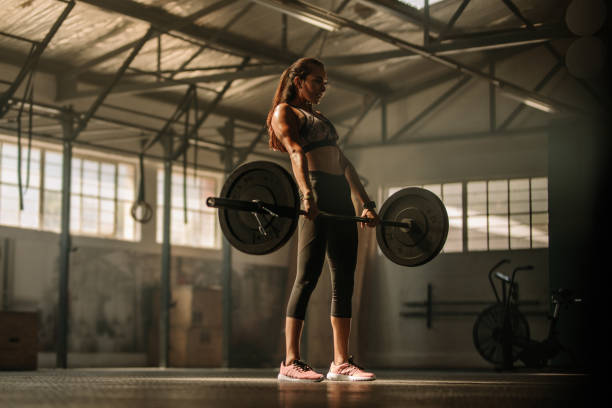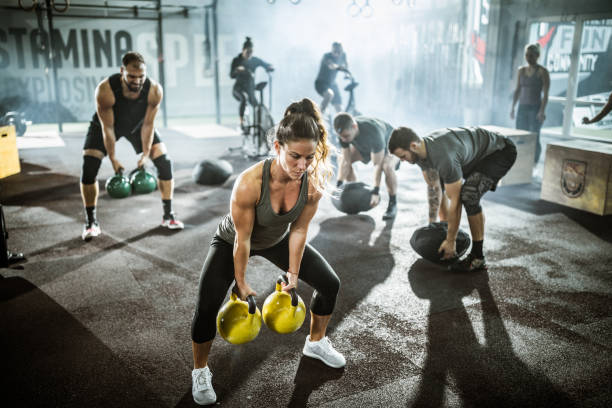CrossFit, the high-intensity fitness phenomenon, has swept through the fitness world, bringing with it a lexicon as robust and dynamic as the workouts it prescribes. Among these terms is “clusters,” a word that might conjure images of closely knit groups but, in the context of CrossFit, represents something far more physically challenging and technically demanding. But what exactly are clusters in the realm of CrossFit, and why should every CrossFit athlete become familiar with them?
In this detailed article, “What Are Clusters In CrossFit,” we delve into the mechanics and benefits of one of the most formidable compound movements found in the CrossFit repertoire. With expertise drawn from seasoned CrossFit coaches and athletes, we break down the cluster, a complex movement that combines a clean and a thruster, into its component parts, demonstrating how it serves as a pinnacle of power and endurance training.
Our exploration goes beyond the mere definition. We aim to impart a comprehensive understanding of how clusters can be seamlessly integrated into your workout routine, the common pitfalls to avoid, and the substantial gains they offer. The cluster is not just a test of physical prowess but also a benchmark of progress and a tool for achieving peak performance.
This content is crafted not only to satisfy your immediate curiosity but to arm you with the knowledge to enhance your CrossFit journey. Whether you’re a beginner looking to understand the basics or an advanced athlete seeking to refine your technique, the value of mastering clusters cannot be overstated.
Join us as we embark on a journey through the world of CrossFit clusters, where every rep is a step towards greater strength, coordination, and explosive power. This article promises to enlighten, educate, and inspire you to embrace the challenge of clusters and elevate your CrossFit experience. So tighten your laces, chalk up your hands, and prepare to tackle the cluster with confidence and skill.
Contents [hide]
What is a Cluster?

A cluster is a paired strength and conditioning exercise combining a hip-dominant lift like the hang clean or power clean immediately followed by an overhead press like the thruster.
Breaking Down the Cluster: Clean and Thruster
The first part of the cluster is the hip-dominant clean variation. This can be a hang clean starting with the bar above the knees, a power clean caught in a quarter squat, or a full squat clean. The key points are to keep the bar close, generate power from the hips, and receive the bar with control.
The second part is the thruster – a front squat to overhead press. Key form points are to descend into a solid front squat position, drive through the heels to stand, and press the bar directly overhead with the arms locked out. The thruster challenges the legs, shoulders, triceps, and core.
Performing these two movements back-to-back completes one cluster rep. You’ll then immediately begin the next rep, making clusters an extremely demanding full-body exercise.
How To Do Cluster Workouts?
When including clusters in a CrossFit workout, proper form and reasonable weights are critical to avoid injury. Take time to master each movement pattern individually before attempting clusters. Start light to dial in technique before increasing the load.
Sample cluster workout formats include:
- Conditioning clusters – Fixed time frame to complete as many reps as possible, like 10 minutes of clean + thruster clusters.
- Rep scheme clusters – Such as 5 clusters every minute on the minute for 10 minutes.
- High volume clusters – Such as 21-15-9 reps for time.
Getting Started with Clusters: Progressions and Modifications
For beginners, break the cluster down into its individual components. Work on front squats, overhead presses, and light cleans separately before combining them. Reduce weight and sets as needed.
Dumbbells or kettlebells can provide a modification by eliminating the technically demanding barbell clean.
Equipment Considerations
Choosing the right barbell and weight plates is important for cluster safety. Opt for a men’s standard 20 kg bar or a 15 kg women’s bar. Use bumper plates to absorb force on the clean, and secure collars to keep plates in place.
Muscles Targeted in a Cluster
Cluster workouts engage nearly every major muscle group in the body. Primary movers include:
- Quadriceps – Pushing through the squat
- Posterior chain – Powering the hip drive
- Shoulders – Stabilizing and pressing the weight overhead
- Triceps – Extending the elbows to lock out the press
Secondary muscles worked include the calves, core, upper back, traps, and biceps. The full-body nature of clusters builds tremendous strength.
Safety Precautions
Staying Safe: Injury Prevention and Warm-Up
To avoid injury, progressively build up volume and weight on clusters over time. Ensure you have proper movement competency before going heavy.
Focus on warming up the spine, shoulders, hips, knees, and ankles through full ranges of motion. Activate the core and practice the cluster pattern with light loads.
Common cluster injuries include lower back strain, shoulder impingement, knee pain, and wrist strain from improper rack position. Listen to your body and reduce weight or volume if feeling excessive fatigue or discomfort.
Benefits of Cluster Workouts

Benefits Breakdown: Strength, Endurance, and More
The combination of heavy strength work followed immediately by conditioning makes clusters an extremely potent training tool:
- Develops muscular strength through heavy cleans and supporting front squats.
- Builds power by emphasizing explosiveness in the clean.
- Tests cardiovascular endurance with minimal rest between reps.
- Increases work capacity as you withstand more volume.
- Engages almost every muscle for greater functional fitness.
- Metabolic conditioning from higher rep cluster schemes burns calories.
Programming Clusters in CrossFit
Clusters are often programmed “for time”, meaning you complete a fixed number of reps as fast as possible. Sets range from just 5 reps up to something like 21-15-9 (descending ladder).
They can also be done for straight sets and reps, like 5×5 clusters with 90 seconds rest between sets. Load and rest periods determine whether strength or conditioning is the focus.
Workout placement also matters – using them while fresh allows greater loads, but doing clusters when fatigued tests willpower. Coaches get creative with clusters.
Cluster Variations
Cluster Variations: Beyond the Barbell
While barbell clusters are the most common, you can perform cluster movement patterns with dumbbells or kettlebells too.
Dumbbell clusters involve a dumbbell hang clean or squat into an alternating or single arm dumbbell thruster. Great for beginners.
Kettlebell clusters feature a double kettlebell clean followed by double kettlebell front squats into a kettlebell thruster. This creates a very demanding cardio test.
Getting creative with clusters keeps training fun and challenging. Don’t be afraid to experiment.
Comparing Cluster Workouts
Cluster vs. Similar Exercises
While unique in their combination of movements, clusters share similarities to other popular CrossFit lifts:
- Cleans also involve a powerful hip hinge and catching the bar in a front rack. However, cleans are not followed by an overhead press.
- Snatches feature the same explosive hip drive and catch, but use a wider grip and overhead recovery. The thruster press is lacking.
- Push press has the dip and drive from the legs to initiate the overhead press, but no clean is performed before.
The cluster stands alone in blending a heavy clean with an immediate thruster press for a total body challenge. Both strength and conditioning are tested to the extreme.
Conclusion
Cluster workouts are a sneaky-hard exercise that will leave even the fittest athletes sucking air by the end. The combination of an explosive hip-dominant lift immediately into an overhead press creates incredible metabolic stress. Nearly every muscle gets tested under fatigue. While technical at first, clusters build tremendous full-body power and stamina. Work on your clean form and overhead pressing strength to make the most of these demanding CrossFit workouts. Used strategically, clusters will quickly improve your conditioning and ability to keep moving when already fatigued.

Trayce served as a grassroots leader and activist in Texas as President of Dallas and Texas Eagle Forum.
Trayce is Mom Caucus Member, Texas Conservative Mamas, Texas Conservative Grassroots Coalition Leader, and Grassroots America Champion of Freedom Honoree.
She currently serves as the Eagle Forum National Issues Chair on Human Trafficking.
Trayce received a Bachelor’s Degree in Marketing from Texas A&M
Currently, she homeschools her youngest child age 13 and graduated her six oldest children, ages 31 to 19.







